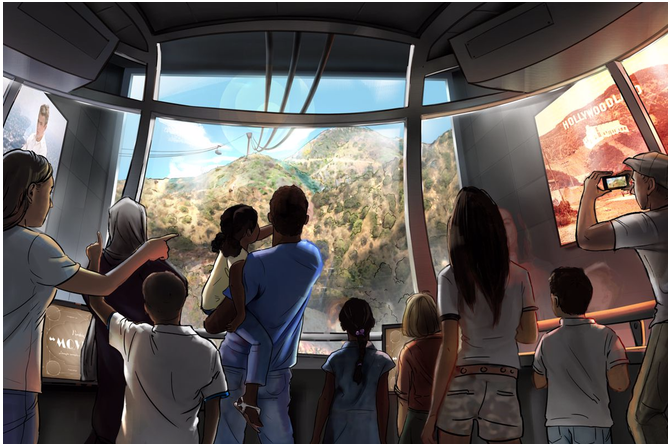CommentsGUEST WORDS--This past summer our family visited Switzerland and northern Italy. During the trip, we had numerous opportunities to ride their amazing transit systems, including several aerial trams.
Because of the interest in building an aerial tram to the Hollywood Sign, I was particularly interested in how these facilities operated, and I was impressed. (Graphic above: Warner Brothers pitches an aerial tram to the Hollywood sign.)
Not only were these aerial trams able to move a large number of people quickly to otherwise inaccessible spots, but they were able to do it with very little impact on the environment. Only a few towers to hold the cables were required, as well as stations at the beginning and end of each line. Despite moving a lot of people, the areas surrounding the stations were also well maintained with little obvious impact from the visitors to the area.
We have searched for years to find a solution for the neighborhoods below the Hollywood Sign that have been inundated with tourists since the advent of automobile navigation systems and Waze. It is my belief that if tourists were offered an attractive alternative way to reach the Hollywood Sign, they would take it. An aerial tram offers an experience that I believe would have a real impact on reducing traffic in those neighborhoods.
The City seems to agree with my assessment. A report issued earlier this summer by the Chief Legislative Analyst and Recreation and Parks Department stated:
“Recreation and Parks strongly believes that this strategy would have the most impact on visitor behavior to both Griffith Park and the Hollywood Sign. If done correctly, this could potentially eliminate traffic from the western side of Griffith Park, areas that include Bronson Canyon, North Beachwood Canyon, Lake Hollywood Drive and Vermont Canyon.”
Although suggestions to install an aerial tram to the top of Mt. Lee date back as far as 1905, people never really considered it to be a serious option until recently. Many thought it was “pie-in-the sky” and could never be financially viable. Now, however, the City has received a concrete proposal from Warner Bros to access the Sign from their parking garage along Forest Lawn Drive, and we know that there are other people interested as well.
This week, the LA Arts, Entertainment, Parks & River Committee approved and forwarded to the City Council a recommendation to begin a feasibility study of an aerial tram. Suddenly, what many thought was a pipe dream looks like it really could become a reality. The City report stated: “Implementation of this option is feasible, but will require environmental clearances, the design and installation of a potentially complex transit system, identification of a vendor to operate the system, and the establishment of start and end points for the system.”
Here are a few things I discovered by surfing the internet. Aerial trams, which are technically known as aerial ropeways, have been around for centuries. In ancient India and Japan, the ropeways were used to cross rivers and were originally made of hemp or rawhide rope. Now they are made from steel cables and towers, but their function is not much different from these original ancient transportation systems. The first ropeways in the U.S. were used for transporting materials to and from mines in the West and were first introduced in 1868.
Today, most of the ropeways in the U.S. are ski lifts. They have rarely been used in urban settings. However, there are three successful applications that can be used as examples – in New York City, Portland, Oregon; and in Telluride, Colorado.
A study by West Virginia University (WVU) concluded that ropeways have seldom been used in urban settings, primarily because engineers are generally not familiar with ropeway technology and specifications. The study concluded that engineers tend to exclude aerial ropeways as an alternative even though there may be advantages in certain applications.
The Hollywood Sign may be one of those possible applications. Bringing an aerial tramway to the Sign is not going to happen overnight – and it shouldn’t. There needs to be a vetting process involving the community and neighborhoods, environmental interests and City departments, and that will take time.
But isn’t it great to see that our leaders are thinking big to try and resolve some of the seemingly intractable issues concerning access to our City’s greatest landmark? Special congratulations to Councilmember David Ryu for his leadership on this effort.
There is a real win-win opportunity here – solving neighborhood congestion issues, creating new jobs, and enhancing the visitor experience in Griffith Park. The Hollywood Sign will turn 100 in 2023. Wouldn’t it be nice if an aerial tramway could be in place (or at least approved) in time for the Sign’s centennial?
(Leron Gubler has been serving as the President and CEO of the Hollywood Chamber of Commerce for the past 26 years. His tenure since 1992 continues to oversee the great comeback story of Hollywood. He is a CityWatch contributor.)
-cw
















